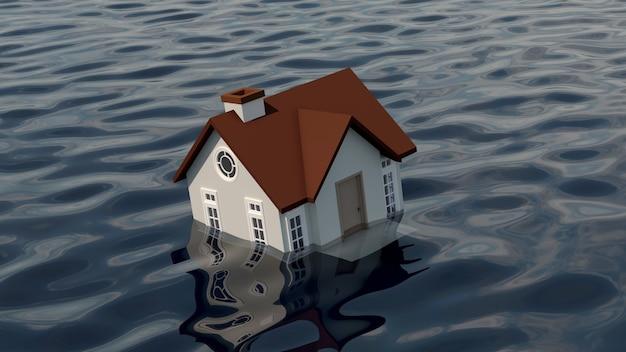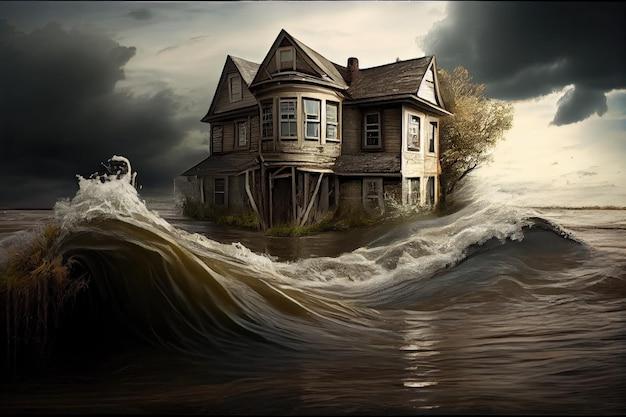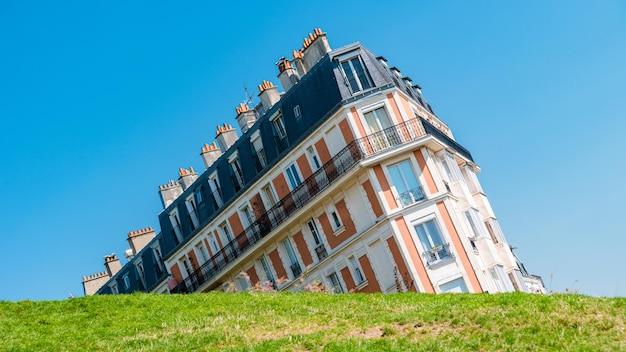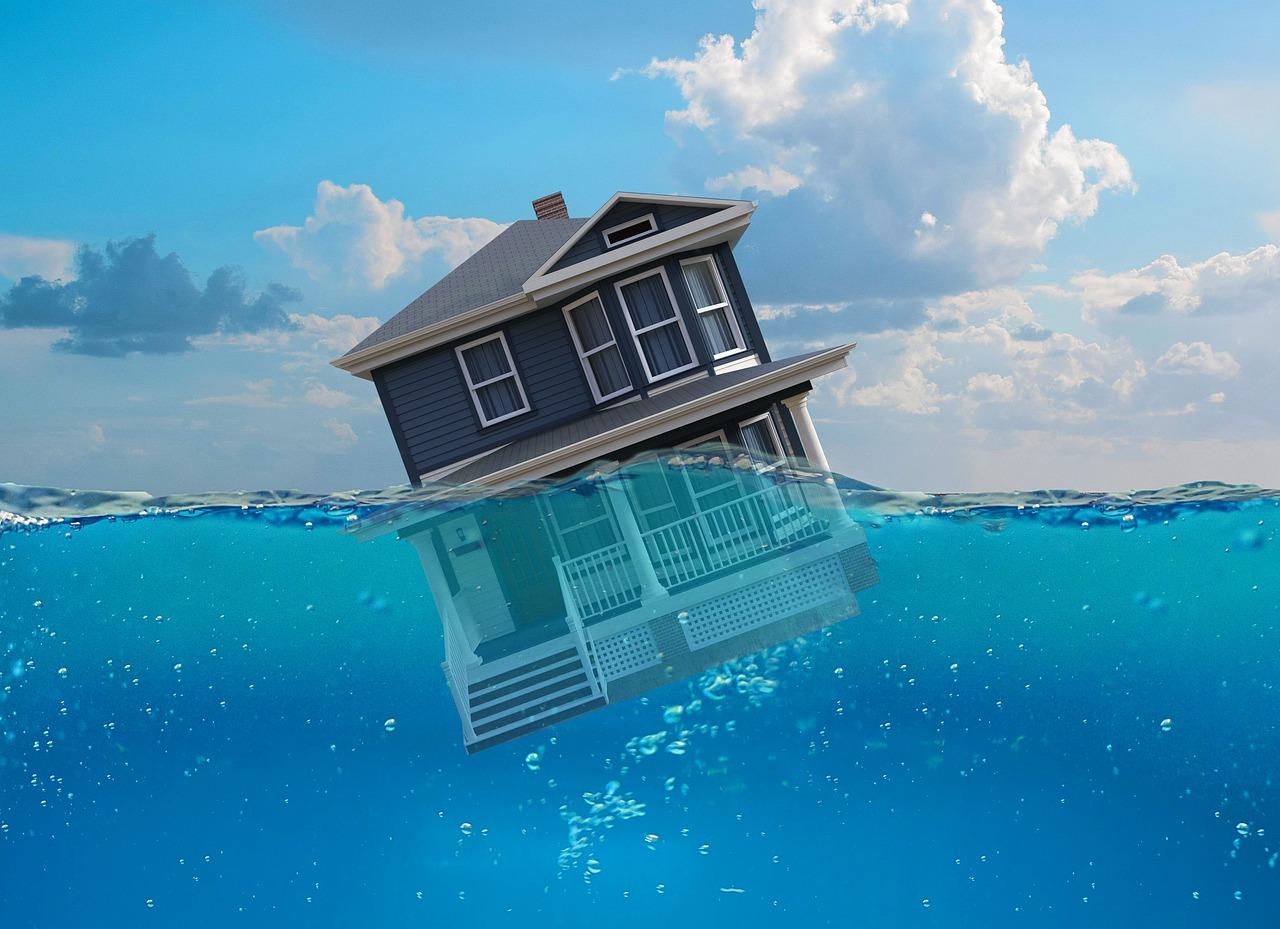Have you noticed cracks forming on your walls or doors that no longer close properly? These could be signs that your house is sinking. Foundation settlement is a common problem that affects many homeowners, and it’s important to address it promptly to avoid further damage. In this blog post, we will explore the warning signs of a sinking foundation, the potential costs of repair, and what happens if your house is indeed sinking. We will also discuss when you should start worrying about your house settling and whether insurance covers the expenses. Don’t let your home sink without taking action – read on to learn how to identify the signs!
How to Spot the Signs of a Sinking House
Has your once perfectly level floor suddenly developed a suspicious slope? If you find your marbles constantly rolling towards one corner of the room or feel like you’re walking uphill in your living room, chances are your house might be sinking. Time to grab a level tool and explore the depths of your floor’s deception!
The Telltale Cracks
Cracks are a house’s way of telling you that it’s not feeling so steady on its feet. Keep an eye out for sneaky little crevices creeping up your walls, floors, or even ceilings. These nasty cracks are like stretch marks for your house, revealing the strain it’s under. So, grab your magnifying glass detective and get ready to spot those subtle stress lines!
A Sticky Situation
Do you find your doors suddenly developing commitment issues? Doors that used to swing open effortlessly now require all your upper body strength just to budge an inch? Well, don’t blame your arm workout routine just yet, as sticky doors can be a sign of a sinking house. Your once proud abode is slowly but surely shifting, causing pesky misalignment. Time to channel your inner lumberjack!
Windows Gone Wild
Are your windows playing tricks on you? If you notice your once perfectly square window frames starting to resemble parallelograms or trapezoids, it might be time to accept that your house is playing a cruel optical illusion. Sinking homes can cause windows to warp and twist, so be prepared for some creative views outside. Who knew your neighbor’s crooked fence could be an artistic masterpiece?
Beware the Bumpy Foundations
Sure, a bumpy ride at the amusement park can be fun, but a bumpy foundation under your house? Not so much. If you notice your formerly smooth concrete base turning into a roller coaster, it’s a red flag that your house might be sinking. So, put on your hard hat and prepare for a not-so-thrilling adventure of leveling and stabilizing your humble abode.
The Infernal Inferiority
Did your perfectly aligned cabinets suddenly morph into a tilting tower of crookedness? If your once luxurious kitchen now looks like a scene out of a Picasso painting, it’s time to acknowledge that your house might be sinking. Inferiority complexes should be left to humans, not houses! So, grab your toolbox and show those cabinets who’s boss.
Laughing at the Lean
If your house starts developing a noticeable lean, it’s time to bring out the measuring tape. Grab a friend, line up the edges of your house, and prepare to be amazed (or horrified) by the results. A leaning house is never a good sign, unless you’re trying to recreate the Leaning Tower of Pisa in your backyard. But let’s be honest, that’s unlikely.
Obnoxious Odors
Sure, funky smells are often associated with dirty socks or questionable leftovers, but sometimes they can be a sign that your house is sinking. If you detect a distinct odor of mold or mildew, it’s time to channel your inner detective and hunt down the source. Sinking houses can lead to moisture buildup, creating a breeding ground for unwanted stenches. Who needs air fresheners when you have a sinking house?
Creepy Crawly Pests
Unwanted guests are the worst, especially when they come in the form of insects or rodents. Sinking houses can create gaps and cracks that invite these creepy creatures to take up residence. So, if a family of mice starts throwing housewarming parties in your living room, it might be time to address the sinking issue before your house becomes a full-blown zoo.
Cracked Plumbing Woes
A sinking house can wreak havoc on your plumbing system, leading to cracked pipes and leaky nightmares. If you notice a sudden increase in water bills or suspiciously wet spots on your walls or floors, it’s time to call in the plumbers. Don’t let your sinking house turn into a water park—unless you’re prepared for an unwanted aquatic adventure.
Remember, while this subsection is all in good humor, it’s essential to take house sinking seriously. If you suspect your house is sinking, consult a professional to assess the situation and find the appropriate solutions to keep your home on solid ground.
Signs of Foundation Settlement
Uneven Floors
One classic sign that something might be off with your foundation is when your floors start to resemble a roller coaster ride. If you find yourself stumbling over furniture because your floors have taken on an uneven, carnival-like quality, well, it might just be time to call in the experts.
Troublesome Doors and Windows
Are your doors and windows suddenly refusing to cooperate? You know, playing hard to open and close, as if they’ve taken up a new career in the world of resistance training? While it might sound like a plot twist in a sitcom, this could actually be a sign that your foundation is having a bit of a meltdown.
Cracks Are Not So Whack
Cracks can be kind of cool when they’re showing up on the dance floor, but when they appear on your walls, that’s a whole different ball game. These sneaky little fissures might be trying to tell you that your foundation has shifted, leaving you with some unwanted decoration.
Let’s Dig Deeper: Other Telltale Signs
Nasty Nails
If you start noticing random, inexplicable nail pops throughout your house, don’t panic—your home isn’t turning into a sentient being. But it might be sinking, which could explain the oddly protruding nails. You might want to consider bringing in the cavalry before your house decides to start tap dancing.
Marvelous Moldings
When your ornate, picture-perfect moldings start looking as if an invisible superhero has taken a chomp out of them, it’s time to channel your inner detective. These damaged trimmings could be trying to tip you off that your beloved abode is undergoing some structural sinking pangs.
Pesky Plumbing Problems
The last thing you need after a long day is to turn on your faucet and be treated to a surprising indoor waterfall. If your plumbing has suddenly developed a fondness for aquatic-themed antics, it could be a red flag that your foundation is taking a downward dive. Wave goodbye to your worries and get professional help!
Key Takeaways
Now that you know the signs of foundation settlement, you can channel your inner Sherlock Holmes and start sleuthing for clues. Uneven floors, troublesome doors and windows, cracks in the walls, pesky plumbing problems, nail pops, and damaged moldings can all indicate a sinking foundation. Don’t let your house play games with you—take action and give your dwelling the support it needs to stay upright and strong.
Sinking Foundation Repair Cost
When it comes to determining the cost of fixing a sinking foundation, the first step is to assess the extent of the damage. This is where you channel your inner detective and play a thrilling game called “Spot the Warning Signs.” Keep an eye out for cracks in your walls, uneven floors, jammed doors and windows, or sudden appearances of the Leaning Tower of Pisa in your living room. These are strong indicators that your foundation might be in distress and in need of some serious TLC.
Calling in the Experts
Once you’ve played detective and successfully uncovered the foundation sinkhole, it’s time to call in the experts. Professional foundation repair companies are the superheroes in this story, armed with the tools and knowledge needed to fix your sinking castle. They’ll swoop in, inspect the damage, and give you an estimate of how much your bank account might be sobbing.
Variables That Affect the Cost
Now, let’s talk numbers. While there is no one-size-fits-all answer to the cost of sinking foundation repair, several factors come into play. The size of your home, the severity of the damage, and the foundation type all dance around, adding suspense to your final bill. Costs can range anywhere between a few thousand dollars to more than your Fortnite skin collection, depending on the magnitude of the issue.
Repair Methods
The foundation repair experts will evaluate the situation and determine the best course of action to fix your sinking ship. There are several methods they might use, from installing hydraulic piers to stabilize your foundation to utilizing good old-fashioned helical piers. These methods involve some fancy engineering magic to lift, level, and restore your foundation, ensuring it no longer feels like it’s having a bad day at the beach.
Fluffing Your Wallet
Now, let’s dive into the budget. On average, sinking foundation repair costs can range from $5,000 to $15,000. However, don’t go putting your treasures on eBay just yet. Remember, this is just an estimate, and the final cost will depend on the size of your home, the extent of the damage, and the recommended repair method. So, make sure you’ve got a little extra padding in your wallet before you embark on this wild sinking foundation repair adventure.
While the cost of fixing a sinking foundation might make your hair stand on end, it’s essential to address the issue promptly. Ignoring the problem can lead to more severe damage down the line and, potentially, leave you swimming in costs that make even Scrooge McDuck blush. So, when you notice those suspicious cracks or your doors start playing hide-and-seek, it’s time to call in the professionals and keep your castle on solid ground.
Signs That Your House Might Be Ready to Tango With the Ground
Are you convinced that your house is eager to perform the limbo with the ground? Well, my friend, let’s look out for some hilarious clues that will have you questioning whether your house is secretly preparing for a not-so-spectacular collapse. Just remember, this dance routine is neither graceful nor entertaining, so let’s get ready to spot some foundation foxtrot fails!
1. The Leaning Tower of No-Pizza
You know something isn’t right when your house starts leaning like the Tower of Pisa, except without the pizza. If you find your floors aren’t quite level, and every time you place a ball on the ground it decides to roll towards the nearest exit, it’s time to seriously question whether your house has some secret dancing aspirations.
2. The Cracked Comedy Show
Cracks, cracks, and more cracks! Not the kind you eat, unfortunately. If your walls start resembling a comedian’s collection of jokes, with cracks running up and down, sideways, and in spiderweb patterns, it might be time to consider that your house is telling you a not-so-funny punchline – it’s ready to take a tumble.
3. The Sinking Sofa
You innocently sit on your favorite sofa, and suddenly, you find yourself sinking into the abyss. It’s like gravity has decided to play a prank on you. If your furniture seems to be swallowed by the floor, and your chairs are rocking more enthusiastically than you do at karaoke night, your house just might be giving you a standing ovation… before it collapses.
4. The Noisy Neighbors
Normally, having noisy neighbors can be annoying, but when it’s your house making the ruckus, it’s a whole other level of disturbance. If you start hearing strange creaking and popping sounds in the middle of the night, like your house is trying to stretch its limbs, you better grab your dancing shoes and be prepared for a spontaneous waltz with destruction.
5. The Door’s Great Escape
Picture this: you’re comfortably lounging on your couch, when suddenly, your front door decides it wants to explore the world beyond your home. It’s swinging open without reason, defying the laws of physics. If you find yourself replacing hinges like you’re getting paid to do it, while your door continues its escape attempts, it’s time to admit that your house might be auditioning for an extreme game of “Through the Keyhole” without your consent.
6. The Drunken Displacement
Ever walked across your home and had the delightful feeling that the floor is unexpectedly moving beneath your feet, making you question if you’ve indulged in one too many cocktails? If your floors start behaving like a tipsy salsa dancer, with dips, sways, and unexpected rises, it might be time to cut them off from the proverbial dancefloor before your house ends up performing an unexpected tango with mother earth.
So there you have it, folks! These hilarious (yet serious) signs might indicate that your house is more than ready to cast its foundation aside and upgrade to a new dance partner – the ground. Remember, it’s better to take action and address these issues sooner rather than later, because no one wants their home to become a sensational viral video sensation!
House Sinking Covered by Insurance: Is Your Home Protected
If you’ve ever found yourself sitting on your sofa, sipping on your favorite beverage, and suddenly realizing that your house feels a little… off, you might start wondering if your home is sinking. It’s a valid concern, and one that many homeowners have. But what happens if your house is indeed sinking? Are you covered by insurance, or are you left to face the sinking ship on your own?
The Dreaded Sinking Feeling
First things first, let’s clarify what we mean by a sinking house. We’re not talking about that sinking feeling you get when you realize you left your phone in a taxi. No, we’re talking about the physical sinking of your home’s foundation. This can happen for a variety of reasons, such as poor soil conditions, water damage, or even geological factors. In any case, it’s not something to be taken lightly.
Does Insurance Cover Sinking Homes
Now, let’s get to the burning question: does insurance cover a sinking house? Well, the answer is… it depends. Insurance policies can be as confusing as trying to assemble a piece of furniture without the instructions. Some policies may cover the repairs for a sinking home, while others might not. It’s important to double-check your policy and read through it with a magnifying glass, just to be certain.
Categories of Coverage
When it comes to insurance coverage for sinking houses, there are generally three categories to keep in mind: dwelling coverage, personal property coverage, and additional living expenses coverage. Dwelling coverage protects the physical structure of your home, while personal property coverage protects your belongings inside. Additional living expenses coverage would help cover costs if you had to temporarily move out due to the sinking disaster.
Sink or Swim with Specifics
To navigate the murky waters of insurance coverage, it’s essential to understand the specifics of your policy. Some policies may exclude coverage for certain causes of house sinking, such as natural disasters or long-term soil erosion. On the other hand, some policies might include coverage for these exact scenarios, acting as a much-needed life raft in troubled times. It’s always worthwhile to know the exact terms and conditions of your coverage to avoid any surprises.
Calling in the Claim Squad
If you suspect that your house is indeed sinking and you’re covered by insurance, it’s time to call in the claim squad. Reach out to your insurance provider and explain the situation. They will guide you through the claims process and let you know what steps to take next. It’s important to document any damage, gather evidence, and keep a detailed record of any expenses incurred during the process.
Safety First, Insurance Second
While insurance coverage is a significant factor to consider, it’s also vital to prioritize safety. If you suspect your home is sinking, take immediate action to protect yourself and your loved ones. Evacuate the premises if necessary and consult with professionals who can assess the situation and provide guidance. Remember, your well-being should always take precedence over any insurance claims.
So, in the event that your house is sinking, insurance coverage can be a lifesaver or a mere drop in the ocean. Check the particulars of your policy, ensure you have the necessary coverage, and don’t hesitate to contact your insurance provider for assistance. At the end of the day, it’s better to be safe than sorry, and with the right coverage, you can navigate the tumultuous waves of a sinking home like a pro.
What Happens if Your House is Sinking
When your house is sinking, it’s not exactly a barrel of laughs. But hey, let’s have a chuckle anyway! Here are some hilarious (not really) signs to look for in case your home is gradually disappearing into the ground.
Cracks in the Walls
No, we’re not talking about your favorite action movie here. If you start noticing cracks appearing on your walls, especially ones that seem to grow bigger and bigger, it might be a sign that your house is playing a disappearing act.
Sloping Floors
Who needs a rollercoaster when you have a sinking house, right? If you feel like you’re constantly walking downhill or have developed a sudden knack for slalom without ever hitting the slopes, it’s time to consider that your house might be sinking faster than a sandcastle at high tide.
Stuck Doors and Windows
Forget about those pesky exercise routines; a sinking house comes with built-in resistance training! If you’re struggling to open or close doors and windows that used to work like a dream, it could be a not-so-subtle hint that your home is slowly sinking into the abyss.
Unwelcome Rainwater
Remember that one time you wanted to put a swimming pool in the living room? Well, turns out, you might not have needed to make all that effort because a sinking house often brings the rain indoors. If you find yourself swimming from room to room during a light drizzle, it’s time to address the sinking situation.
Strange Noises
Have you been hearing mysterious creaks, moans, and groans around your house? No, it’s not haunted (probably). It might just be the sound of your home’s structural integrity giving in to gravity’s persuasive charms. Time to investigate before your floors turn into a xylophone.
Foundation Issues
Who doesn’t love an unstable foundation? If you notice your house settling in a way that makes it look like it’s taking a nap, it’s time to wake up and smell the sinking. Uneven foundation can lead to serious structural problems, so better get that checked out before your house decides to relocate without your permission.
Plumbing Woes
You know those annoying leaks that always seem to happen at the most inconvenient times? Well, a sinking house can make them even more exciting! As your home shifts and contorts, so do your plumbing pipes. So, if your faucets and toilets start spreading joy by showing off their gymnastic abilities, it’s a tell-tale sign that your house is sinking.
Wrapping Up (Like Your Sinking House — Sorry!)
Now that you know the hilarious (not really) signs of a sinking house, it’s time to take action. Remember, a sinking house is no joke, so get a professional to assess the situation and come up with a plan to save your home from becoming an unintended submarine. It’s sink or swim, people — and no, in this case, swimming is not an option!
When to Start Fretting About Your House Settling
So, you’re lounging on your couch, binge-watching your favorite show, when suddenly, you notice a tiny crack in the wall. Should you start panicking? Well, not necessarily. Sometimes houses settle over time, just like your lazy cat slouching in its sleep. But how do you distinguish between the normal quirks of a settled house and the sinking feeling of a major problem? Here are a few signals to watch out for:
Structural Stress-Indicators
-
New Gaps and Cracks – While cracks can be as common as grey hairs, it’s the fresh ones that raise eyebrows. Keep an eye out for new gaps around windows, doors, or along the foundation. If those crevices are looking like the Grand Canyon, it might be time to take action.
-
Wonky Windows and Doors – Have your once-flawless doors and windows turned into rebellious troublemakers that refuse to open or close smoothly? If they stick more than a pack of gum on a hot summer’s day, it could be a sign of your house throwing a tantrum.
-
Sloping Floors – Who needs a treadmill when you can get your daily workout just by walking from room to room? If your floors feel like a funhouse with their ups and downs, your home may be trying to become the next great rollercoaster ride.
When Normal Turns Abnormal
Of course, a little settling is normal, like when your stomach adjusts after a satisfying meal. But how do you know when it’s gone from a gentle pat on the back to a mighty shove in the gut? Here’s when you might want to put down that ice cream and start paying attention:
1. Big Movements – If your house decides to throw a party and starts shimmying and shaking like it’s doing the twist, that’s not just normal settling. That’s the house equivalent of full-on breakdancing. Break out the caution tape and call for backup!
2. Cramped Pipes and Disobedient Wiring – If you notice your once-roomy pipes and wires suddenly start complaining and causing a fuss, you might have more than just a simple settling issue on your hands. Let’s face it, no one likes cramped living conditions, not even pipes and wires.
3. Stubborn Staircases – When your stairs turn into an obstacle course with extra surprises at every step, it’s time to unleash your inner detective. If each ascent requires the focus of a tightrope walker, you’re not dealing with ordinary settling anymore.
Don’t Panic, Plan Instead
So, your house is showing some unsettling signs, and you might be contemplating running for the hills. But take a deep breath (unless you’re already outside), and remember that panicking never solved anything. The key is to stay calm and take action:
-
Monitor the Monuments – Keep a vigilant eye on any structural changes. Taking regular measurements of cracks and gaps can give you a clearer picture of whether your house is undergoing a mild disturbance or full-blown demolition.
-
Call for Reinforcements – When in doubt, call in the experts. Professional engineers and contractors have the know-how to assess and diagnose the situation accurately. Don’t rely on your Great Aunt Mildred’s theories about strange noises and ancient curses.
-
Make Friends with Repairs – Sometimes, a little TLC is all it takes to get your house back on its feet (or foundation, rather). Be open to necessary repairs and tackle them head-on. Who knows, you might even get to wear a cool tool belt in the process.
So, the next time you feel that subtle shimmy or see a tiny crack, remember to take a closer look. While house settling is as natural as the passing of time, it’s important to differentiate between harmless dips and alarming dives. Stay watchful, stay informed, and most importantly, stay on the right side of the cracks.



